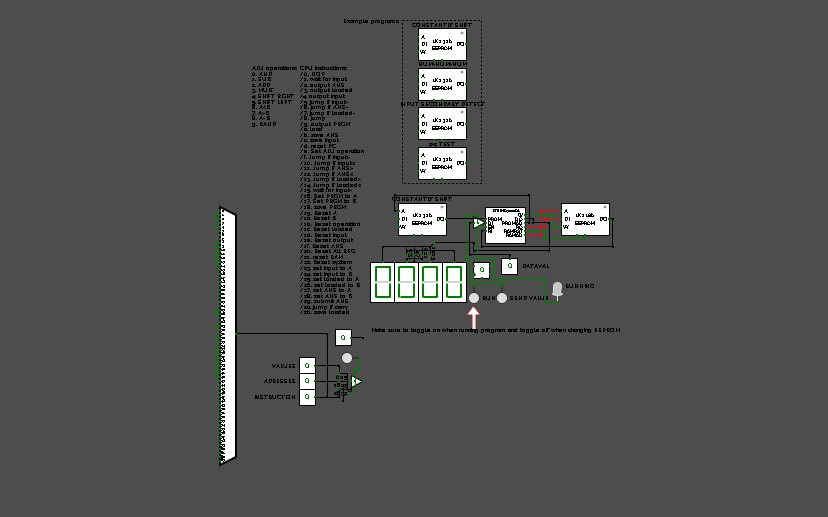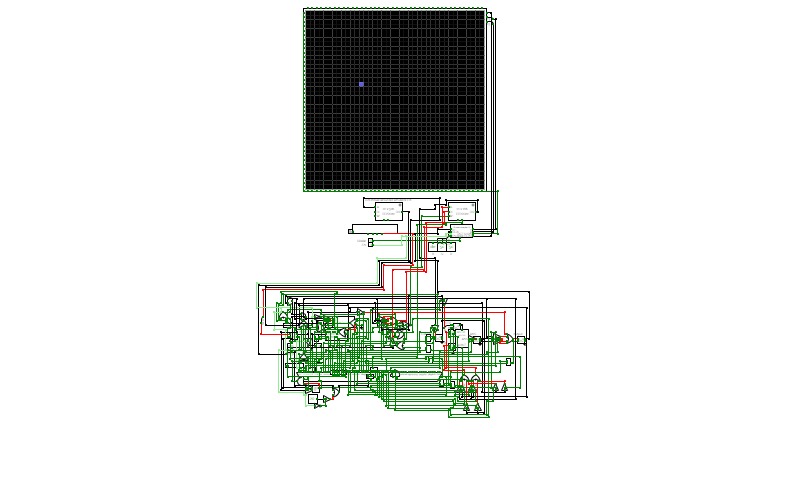STRING CPU 3000SA
STRING CPU 3000SAThe Sixth string CPU has finally arrived. This new CPU has a new function in the ALU called RAND This is a simple function which the ALU can output a random value. The second new thing is the way the string CPU writes to the value memory. In the older string CPUS, the write pin would be triggered when a value above 0 is detected being saved in a save instruction, which severely bottlenecks the processor's ability to operate. since you can't override a value above 0 with 0 in the memory. This new system, however, activates the write pin when a save instruction is detected. This means that values in the memory can now be overridden with 0 in save instructions!
CPU instructions:
/0. NOP- no instruction at this address
/1. wait for input - stops PC until an input (other than zero) value is detected through DI
/2. output ANS - output ALU ANS
/3. output loaded - output loaded data from RAM
/4. output input - output value in DI register
/5. jump if input= - skip to different part of program if a certain value is detected in DI (address can be selected by setting the value in the "addresses" stepper)
/6. jump if ANS= - same as 5 but for ANS
/7. jump if loaded= - also same as 5 but for loaded
/8. jump - like 5, but the skipping is unconditional
/9. output PRGM - output the value from the 'Values" section in the program EEPROM (make sure you have the program value at the same time as the instruction)
/10. load - load a value from RAM (make sure you have your address from the "addresses" section at the same time as the instruction)
/11. save ANS - save ALU ANS to RAM (make sure you have your address from the "addresses" section at the same time as the instruction)
/12. save input - save value in DI to RAM (make sure you have your address from the "addresses" section at the same time as the instruction)
/13. reset PC - resets the PC
/14. Set ALU operation - sets ALU CTR (set ALU CTR by using "values" section at the same time as instruction Value= OPCODE value)
/15. Jump if input> - jumps if input is > than program value (make sure you have the instruction, address, and value at the same time.)
/16. Jump if input< - same as 15, but <
/17. Jump if ANS> - same as 15, but for ALU ANS
/18. Jump if ANS< - same as 16, but for ALU ANS
/19. Jump if loaded> - same as 15, but for loaded
/20. Jump if loaded< - same as 16, but for loaded
/21. wait for input= - waits for a certain DI value (DI register doesn't save)
/22. Set PRGM to A - sets program value to ALU input A (have your value from "Values" section as same time as instruction)
/23. Set PRGM to B - same as 22, but for ALU input B
/24. save PRGM - saves program value to RAM (make sure you have the instruction, address, and value at the same time.)
/25. Reset A - resets ALU input A
/26. Reset B - resets ALU input B
/27. Reset operation - resets ALU CTR
/28. Reset loaded - clears loaded data in loaded register
/29. Reset input - clears value in DI register
/30. Reset output - clears value in output register
/31. Reset ANS - clears data in ALU ANS register
/32. Reset All REG - clears data in all registers in CPU
/33. reset RAM - clears all data in RAM
/34. Reset system - clears all data off RAM and registers
/35. set input to A - sets value in DI register to ALU input A
/36. set input to B - same as 35, but for ALU input B
/37. set loaded to A - sets loaded value to ALU input A
/38. set loaded to B - same as 37, but for ALU input B
/39. set ANS to A - sets ALU ANS to ALU input A
/40. set ANS to B - same as 39, but for ALU input B
/41. submit ANS - submits ANS to ANS register (make sure you use this instruction before clearing ALU inputs otherwise the ANS will be lost)
/42. jump if carry - same as 5, but if ALU COUT = 1
/43. save loaded - saves loaded value to memory (make sure you use instruction and address at same time)
ALU operations:
0. AND
1. SUB
2. ADD
3. MULT
4. SHIFT RIGHT
5. SHIFT LEFT
6. A<B
7. A>B
8. A=B
9. RAND
There is a programming machine that you can connect an empty EEPROM (make sure bit width is 32 and address width is 10 and don't ever use ram for programming!!!). make sure that your program is starting at EEPROM address 2 and increase the EEPROM address by one every instruction you write to EEPROM otherwise you are essentially constantly overriding instructions! (I know, disgusting machine code. Comment in string CPU comparison if you want to, suggest a way to type code for the CPU.)
A LOOK INSIDE STRING3000SA
A LOOK INSIDE STRING3000SAFor those who want to see what is going inside string3000SA









